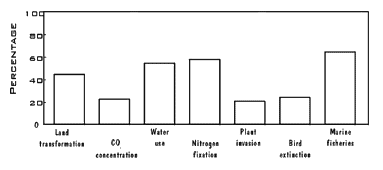|
BOX 2.
UNPRECEDENTED ENVIRONMENTAL CHANGES:
NEW CHALLENGES FOR HUMANITY
Assertions about environmental changes grab headlines. Sorting out fact from fiction, however, is frequently
problematic. Fortunately, credible information is available for some important phenomena. The following
summary highlights a number of global-scale changes where the information is quantitative and well-documented,
the rates of change are known, and the causes are understood (Vitousek et al. 1997b and
references therein). These global-scale indicators of change provide a credible platform for discussing
environmental challenges.
Between 40 and 50 percent of the land surface of the planet has been transformed by human action.
Examples include the conversion of wetlands and forests to urban and industrial areas or of
grasslands to pastures and agricultural fields. These transformations affect climate, biodiversity,
human health, and the delivery of critical ecosystem services. The concentration of carbon dioxide in the atmosphere has increased by 30 percent since the beginning of the Industrial Revolution.
Because we can "fingerprint" this heat-trapping, greenhouse
gas, we are certain that the increase is a direct result of human activities, primarily the burning of
fossil fuels. Humanity currently utilizes over half the available surface freshwater of the planet. About 70
percent of that amount is used in agriculture. Diversions and impoundments have altered river
systems substantially, with only 2 percent of U.S. rivers now running unimpeded. Demands for
clean water are expected to rise as the human population grows exponentially. Human actions have doubled the amount of fixed nitrogen annually since the beginning of the 20th century.
This additional fixed nitrogen—produced deliberately by the making of fertilizers and
inadvertently as a byproduct of fossil fuel combustion—affects human health, climate, biodiversity,
urban smog, acid rain, fish kills, dead zones, and harmful algal blooms in coastal waters (see
Box 4). Invasions of nonnative species are increasing globally, with more than half of the plant species on
islands and 20 percent or more on continental areas frequently nonindigenous. This rearrangement
of the biota of the planet is occurring at vastly greater rates due to human activities. Most
biological invasions are irreversible; some have serious economic and ecological consequences. One-quarter of the bird species on the planet have gone extinct, due primarily to human actions
(hunting, introduction of invasive species, and habitat destruction). Birds are one taxon for which
reliable information about extinctions exists. For lesser known taxa, credible estimates suggest that
rates of species extinctions are approximately 100 to 1,000 times those before humanity's dominance
of Earth. Two-thirds of the major marine fisheries are now fully exploited, overexploited, or depleted. Just
over 40 years ago, this figure stood at less than 5 percent. Currently, 22 percent are overexploited
or already depleted, and 44 percent are at their limit of exploitation. In addition to the reported
biomass of landed catches, an additional 27 million tons of bycatch are discarded annually, nearly
one-third as much as total landings.

FIGURE 1. Human dominance or alteration of major components of the Earth system. Data are
expressed as (from left to right) percentage of the land surface transformed; percentage of the
current atmospheric
CO concentration
that results from human action; percentage of accessible
surface freshwater used; percentage of terrestrial N fixation that is human-caused;
percentage of plant species in Canada that humanity has introduced from elsewhere; percentage
of bird species on Earth that have become extinct in the past 2 millennia, almost all of
them as a consequence of human activity; and percentage of major marine fisheries that are
fully exploited, overexploited, or depleted. Figure is reprinted with permission from Vitousek et
al. (1997b). concentration
that results from human action; percentage of accessible
surface freshwater used; percentage of terrestrial N fixation that is human-caused;
percentage of plant species in Canada that humanity has introduced from elsewhere; percentage
of bird species on Earth that have become extinct in the past 2 millennia, almost all of
them as a consequence of human activity; and percentage of major marine fisheries that are
fully exploited, overexploited, or depleted. Figure is reprinted with permission from Vitousek et
al. (1997b).
It is clear from these seven global-scale indicators of change that human activities are transforming the planet in
new ways and combinations at faster rates, and over broader scales than ever before in the history of humans on
Earth. Our activities are inadvertently changing the chemistry, the physical structure, and the biology of the planet.
Accelerated efforts to understand Earth's ecosystems and how they interact with the numerous components of
human-caused global changes are timely and wise.
|

![Environmental Science And Engineering For The 21st Century: The Role of the National Science Foundation [NSB 00-22, February 2000]](images/f3_title.gif)

![Environmental Science And Engineering For The 21st Century: The Role of the National Science Foundation [NSB 00-22, February 2000]](images/f3_title.gif)